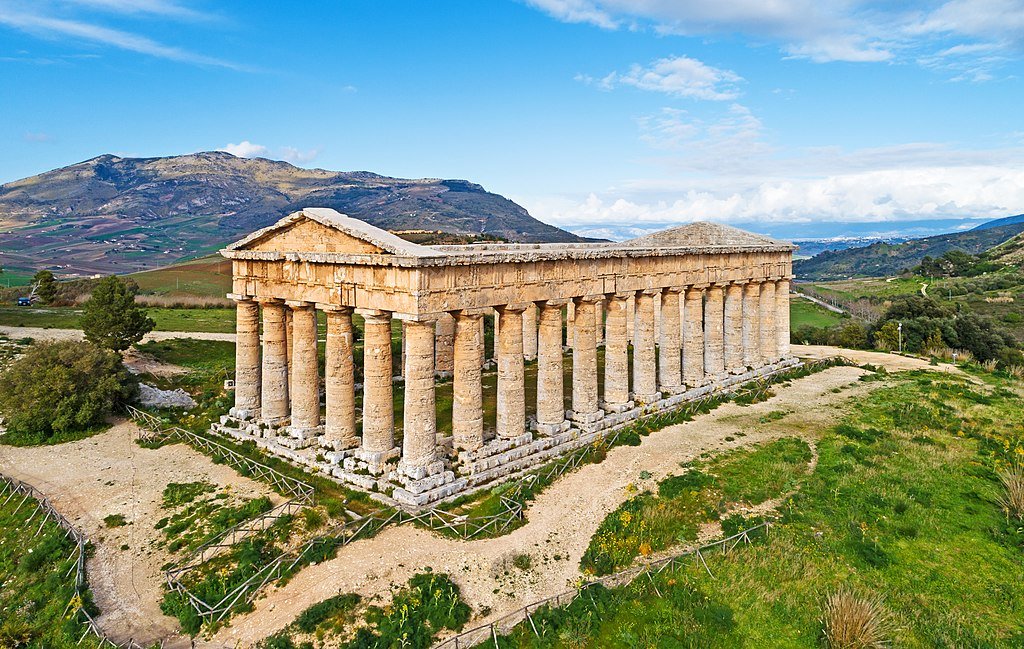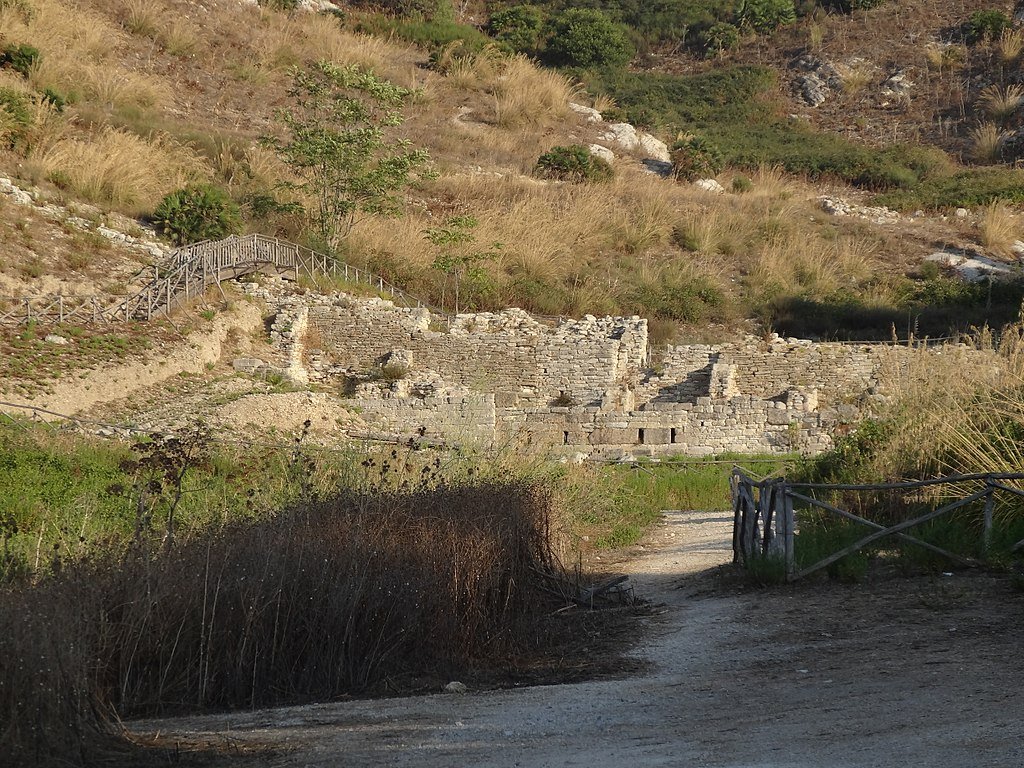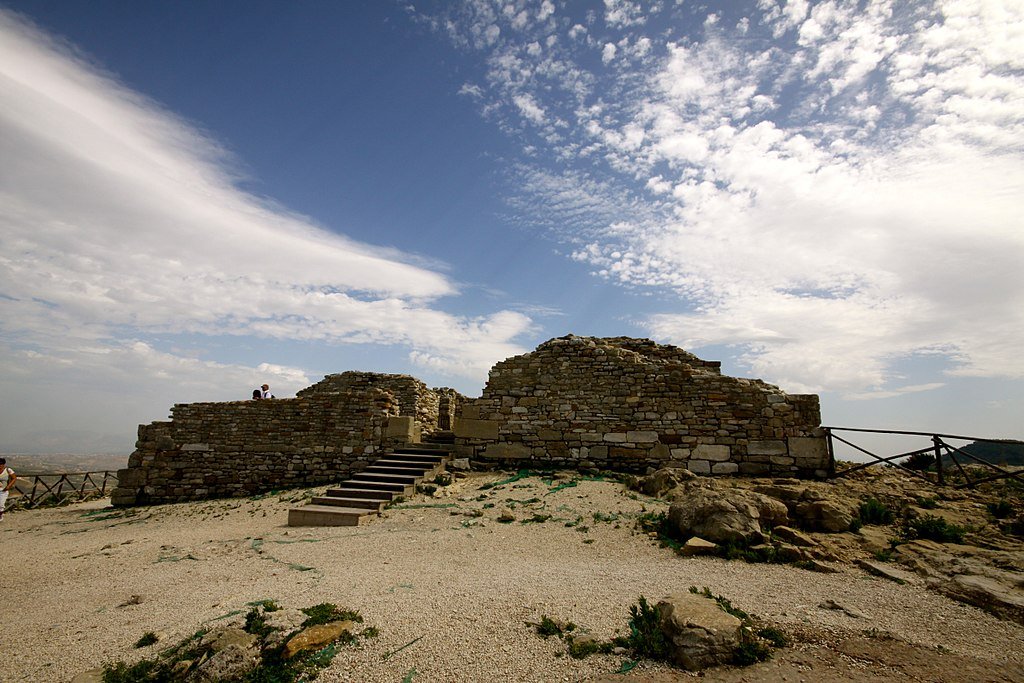Guide to Segesta, Sicily - An Ancient Elymian Settlement
Sitting atop a hill overlooking the Gulf of Castellammare and surrounded by beautiful countryside, the Segesta archaeological park is one of the loveliest ruin complexes in Sicily. The stunning temple, among the world’s finest examples of Doric architecture, is incredibly well-preserved and has sat unfinished for more than 2,500 years.
Even if the ancient town of Segesta, for which the temple was built in the 5th century, has almost completely disappeared, the temple still stands there proudly, along with the impressive Greek-Roman amphitheater, perched high up on Mount Barbaro with breathtaking views over the surrounding green hills.
This site reflects the presence of many ancient civilizations, starting with the Elymians, one of the indigenous peoples of pre-Greek Sicily. Following the Elymians, Segesta became Greek, then Roman, Byzantine, Arab, and Swabian all one after the other. Each of these peoples has left their footprint here.
Table of Contents
Plan your itinerary with local help
If you could use some help planning your visit to Sicily, consider scheduling a Sicily travel consultation with Giorgio, our Palermo-based local expert!
These are one-hour Zoom calls where you’ll get to chat with Giorgio about the trip you’re planning and he’ll share his tips and advice, answer your travel questions, and help you perfect your itinerary.
Why visit?
If you’re interested in Sicily’s history during its time as a part of Magna Graecia, Segesta is a must-visit destination. The site’s majestic Greek temple is among the best-preserved in the world and it’s theater, which is still in use today, is quite impressive.
Despite this, Segesta is one of Sicily’s least visited ancient ruins. Yes, the site is in a rural area that isn’t conveniently located next to other major points of interest, but I think this “disadvantage” or inconvenience is actually its greatest beauty:
Segesta’s slightly peripheral position, tucked away and surrounded by nature, gives the site a serene, bucolic atmosphere. Picture a perfectly preserved white stone temple standing on a hill, in the middle of meadows dotted with wildflowers. That’s what you’ll find here.
Moreover, the site is far less crowded than the Valley of the Temples, and as long as you avoid the tour buses (which usually arrive mid-morning), you won’t have to worry about masses of people or anything liek that.
Also, as I mentioned above, the ancient theater is still in use, which means you can even attend a show here (during the summer months). In summer, during the so-called Segesta Teatro Festival, there are live performances held in the evenings.
Where is Segesta?
The Segesta Archeological Site lies in the northwestern part of Sicily, a bit inland and near the town of Calatafimi, in the province of Trapani. Trapani is just 35 km to the northwest, while Palermo, Sicily’s capital city, is 75 km to the northeast.
The temple, Segesta’s star attraction, sits on a low hill surrounded by green meadows. As you drive up to the site, you can admire the magnificent temple standing high among green hills against a vivid blue sky.
On the top of a nearby hill named Mount Barbaro, about 400 meters above sea level, lies the semicircular theater. From there, you can enjoy a wonderful view. The countryside provided (and still does!) a natural backdrop to the scenes on stage during performances.
How to get to here
Arriving by bus from Palermo
Despite its rural location, Segesta can be reached fairly easily by public transportation from Palermo. The bus company Segesta Autolinee runs regular weekday buses all throughout the day from Palermo to Trapani, stopping at the town of Calatafimi along the way. Calatafimi is 7 km from Segesta, so you’ll want to get off at this stop. The ride takes about 40 minutes and one-way tickets cost €7.
From Calatafimi, you’ll need to catch the Tarantola bus, which departs from Piazza Duca degli Abruzzi (in town) and heads to the archaeological site.
This ride takes 20 minutes and the bus leaves regularly throughout the day. Remember that buses usually do not run on Sundays and public holidays.
Arriving by car
If you’ve got your own car and will be coming from Palermo, you can reach Segesta in about an hour by driving along the E90 road. When you reach Segesta, you’ll find a park and ride lot where you’ll leave your car and hop on a shuttle bus.
The shuttle bus will take you to the main entrance of the site, about 1.2 km away. The bus leaves every 15 minutes and tickets for the ride and parking cost €5.
Alternatively, if you’re coming from Trapani, the city is just 35 km away, and the route to get here is along the A29 highway that connects Trapani to Palermo. Take the exit Segesta and park your car at the aforementioned park and ride, then board the shuttle bus.
Avoid parking along the street or anywhere other than the official parking lot, as you’ll most likely be fined if you do so.
Where to find a car rental
Assuming you’ll be starting your Sicily trip from the airport of Palermo, you’ll have no trouble getting a rental. You have agencies directly at the airport, by the train station, and in the city center.
To check prices and book, I recommend using DiscoverCars. It’s a car rental website includes offerings from all the major international rental companies as well as lots of smaller local agencies, which often have much better pricing. You can often find great deals.


Logistics of planning your visit
Opening hours
The site is usually open daily from 9 AM to 6:30 PM, with slightly reduced hours in the wintertime (a 5:00 PM closure). Last entry is allowed up to one hour before closing.
Admission tickets
Tickets cost €10 per person for anyone over age 25, €5 for those aged 18-25, and free for children under 18. You can buy tickets from a booth where the shuttle drops you off.
Every first Sunday of the month, entry is free for everyone.
Be aware that the walk from the temple to the theater is quite steep, so if you want to avoid that, you can jump on a shuttle bus that connects them. Round trip tickets cost €2 and there’s no need to buy the ticket in advance.
Best time of day to visit
Come early in the morning, before the tour buses arrive. If you arrive at about 8:45 AM, you’ll be able to catch the 9:00 AM shuttle (the first of the day) and will reach the temple when there are almost no other people around.
As I said above, Segesta is rarely very crowded, but even so, it’s glorious to visit first thing in the morning when you can explore the site with no one else around.
How long does a visit take?
I recommend about 2 hours for a comprehensive visit the archaeological park, which has the incredible temple, an old tower, the ancient agora, a mosque, a church, the ruins of a castle, the Greek-Roman amphitheater, the second acropolis, and a sanctuary.
It is quite a big site, so be prepared for some walking and if visiting during hotter times of year, bring a hat, sun cream, and plenty of water.
Should you walk along the path or take the shuttle bus?
Since the site is so large, I think it’s worth taking advantage of the shuttle bus, which runs regularly between the temple and the theater throughout the day. The walk between the two sites is steep, so if it's too hot – or you don't feel fit enough – it could be challenging.
The temple is not far from the ticket office (about 400 meters), but the distance from the entrance to the theater is 1.7 km. If you choose to explore the sight entirely on foot, you will walk around 4 km in total to visit all of the park's points of interest.
Main sights




The Doric temple
The temple of Segesta, right outside the city walls, was built in the 5th century BC by the Elymians, the indigenous Sicilian people who also founded Erice.
It has no roof because it was probably unfinished due to an attack on the city. It is 61 meters long and 26 meters wide, with 36 Doric columns around its perimeter.
The fortification walls
The city walls, built in the 5th century BC, encircled the western side of the mountain and were equipped with towers. You can still see some of the city gates: Porta di Valle, Porta Bastione, and Porta Teatro.
The north acropolis
The ancient city extended on two peaks and consequently had two acropolises. From the north acropolis, you can see the theater, the agora, a macellum (a Roman indoor market), a bouleuterion (an assembly house), a late Byzantine settlement, a Muslim mosque, the remains of a Swabian castle, and a church found in 1442.
The theater
The theater sits on the north acropolis of the city and dates back to the 2nd century BC. It was built using local limestone, and it could accommodate up to 4,000 people.
The Romans renewed it during the Imperial age, and today it still hosts concerts, classical and modern plays, and other events (in the summer).
The south acropolis
The south acropolis was protected by steep natural walls and you can still see dwellings here carved into the rock. In the Mango district, slightly south of the acropolis, is a sanctuary dating back to the 4-5th century BC.
My suggested Segesta itinerary
Start your itinerary by visiting the temple, just a 5-minute walk from the ticket office. Then, jump on the shuttle bus or tackle the uphill path toward the theater.
Your first stop on the way to the theater will be Porta di Valle, a city gate along the fortification walls. Continuing along the footpath, you’ll stumble upon an old defensive tower and Porta Bastione, another city gate.
Nearby, you can also see a Byzantine settlement.
Next, head to the north acropolis where the agora once stood. It was the beating heart of the ancient city, with a macellum and the bouleuterion. This is where public daily life took place.
Continuing on toward the theater, you will discover a very different set of ruins, which tell of Segesta’s history following the Greek and Roman periods: the Arabs came here next and you can still see the mosque that they build later the agora. Later, the Swabians built a castle whose ruins you can still see atop the hill.
Finally, you’ll finish your tour at the hilltop theater, where you can enjoy fantastic views of the surrounding countryside.
As you descend back toward the park entrance, make sure to follow the path which offers you a view of the fortification walls. You can also hop on the shuttle bus to come back if you don’t feel like walking.
And for anyone who wants to visit the south acropolis, you’ll need to divert off to the the path that leads there, before you leave the site.
A few final tips
A picnic at the archeological park: Why not take some food with you and enjoy a picnic here? There is a free, equipped area with shaded benches and tables that’s a great spot to take some rest, cool off, gran a bite, and enjoy the peaceful surroundings before leaving
On-site facilities: There’s a refreshment area next to the ticket office, where you can buy water or something light to eat. On the right, you can also find the bathrooms (free access).
A stop at the Terme Segestane: If you’re traveling by car, consider stopping at the Terme Segestane, just 9 km from Segesta along the road SP2. It’s an open-air spa open from June to September, where you can dip into the hot-water pools.
Guided tours
You can easily visit Segesta on your own, but if you prefer to be accompanied by a guide, you’ll need to arrange a private visit in advance, as the park does not offer guided tours on-site.
In Summer, you may find a guide available at the park entrance, but it’s not a service provided by the park, so there are no guarantees.
For a lovely full-day tour of Segesta that includes visits to nearby Erice and the coastal salt pans, we always recommend veteran local guide Giorgio Calò.



Connect with Giorgio














